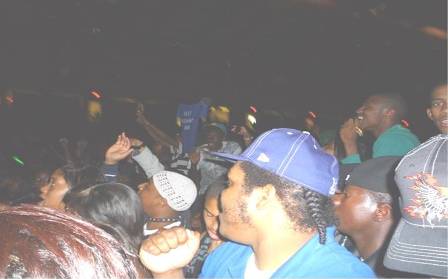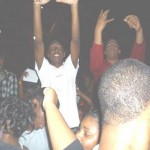
By Kendra Johnson
UJW
UPPER MARLBORO, Md. – After being frisked by security, area teens enter the Showplace Arena where the annual Spring Peace Bounce is happening. They listen to their favorite Go-Go bands, dance the night away and simply have fun.
Go-Go is funk-style music that started in Washington, D.C.
Even though the party at Showplace Arena was long anticipated, the fun doesn’t last.
A little after 11 p.m., the party now over, the teens crowd outside Showplace Arena — some waiting for rides to leave, some looking for new “friends” to make, and others anticipating someone to throw the first punch.
“They come fresh and other people step on their shoes or whatever and they get mad and want to fight,” said Dashauna Grogan, 16, a Friendship Collegiate Academy student.
Coming “fresh” is well dressed in the latest styles.

Like many Go-Go parties that attract young adults, fight is a common thing at the events. Some of the disturbances have even ended in death.
Why do people tend to fight after Go-Gos?
“I think kids these days feel obliged to fight, so they find a reason to fight and then they fight,” said Eli Lee Raiford, a 17-year-old Bladensburg High School student.
Marcel McIntyre, a Suitland High School 11th-grade student, said that people fighting at Go-Gos have “become something to expect.” He also says, “It’s a matter of respect. No one wants to be disrespected in front of their friends and when it happens, you really don’t have a choice.”
Some fight for popularity, said Tevin White, a Northwestern High School 1 0th-grader. “People want to be known, so they fight to get their name put out there. It’s mainly a lot of ‘hood beefs,” referring to neighborhood confrontations.
That’s what happened to McIntyre, after attending a recent Go-Go.
“It was a while back. My friend and I were fighting these dudes because they were calling us out,” or disrespecting their neighborhood. “… And that’s when we got to fighting.”
The fight was broken up by security.
These altercations happen at the possible expense of other people getting injured, as crowds often rush to see the brawl.
Local police don’t keep records of fighting specifically at Go-Gos unless something drastic occurs.
Some of the fights have resulted in death.
“Three of my friends died,” said White.
“Too many people dying, added Eddie Davis, a junior at Northwestern. “It’s terrible.”
Brutal fistfights aside, Go-Gos are likely to be around. There are 140 venues that regularly host Go-Go events throughout Maryland, D.C., and Virginia, accor ding to GogoBeat.com. And there are still others that host them occasionally.
Recently, Prince George’s County (Md.) Executive Jack Johnson closed nine area Go-Go clubs that had a high frequency of police calls for violent incidents.
Despite the action, it’s unlikely to end the fighting at Go-Go’s.
“Sometimes, they fight to fight, like that’s their goal — to fight someone before the night is over,” Grogan said.

